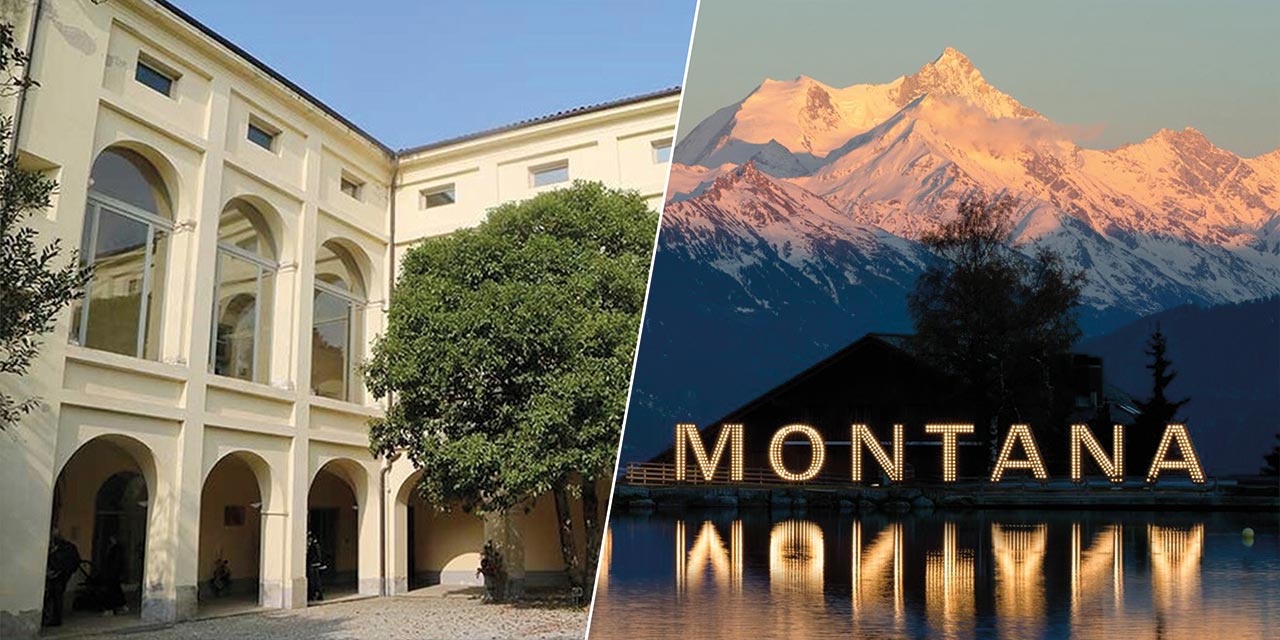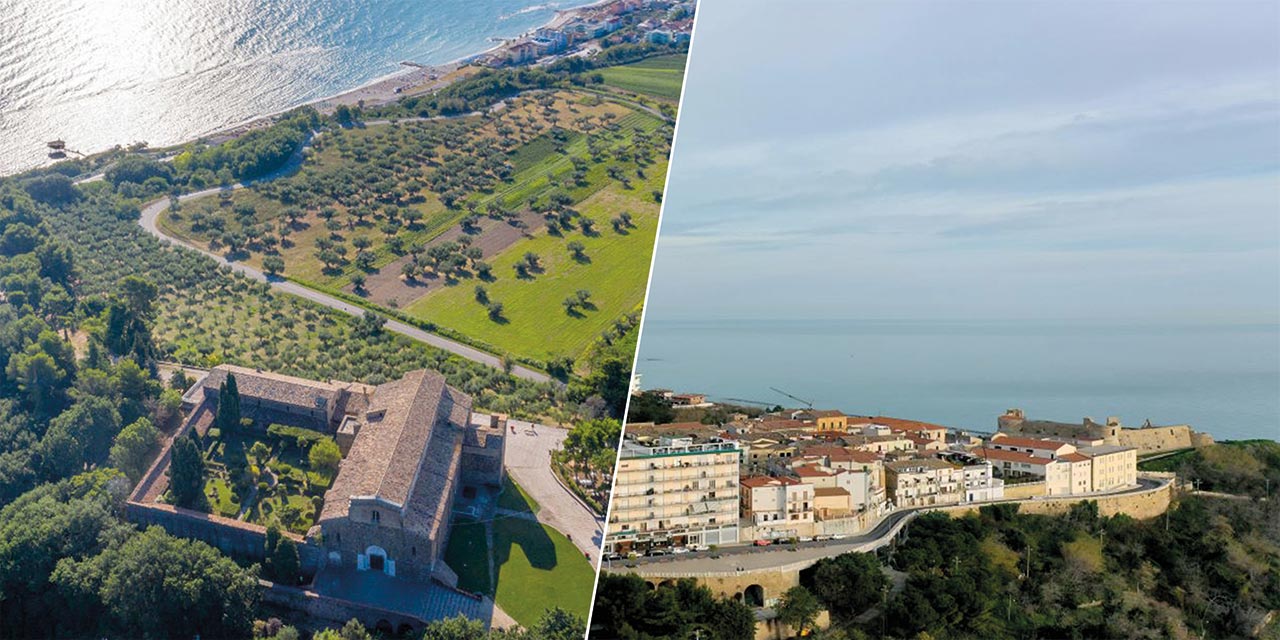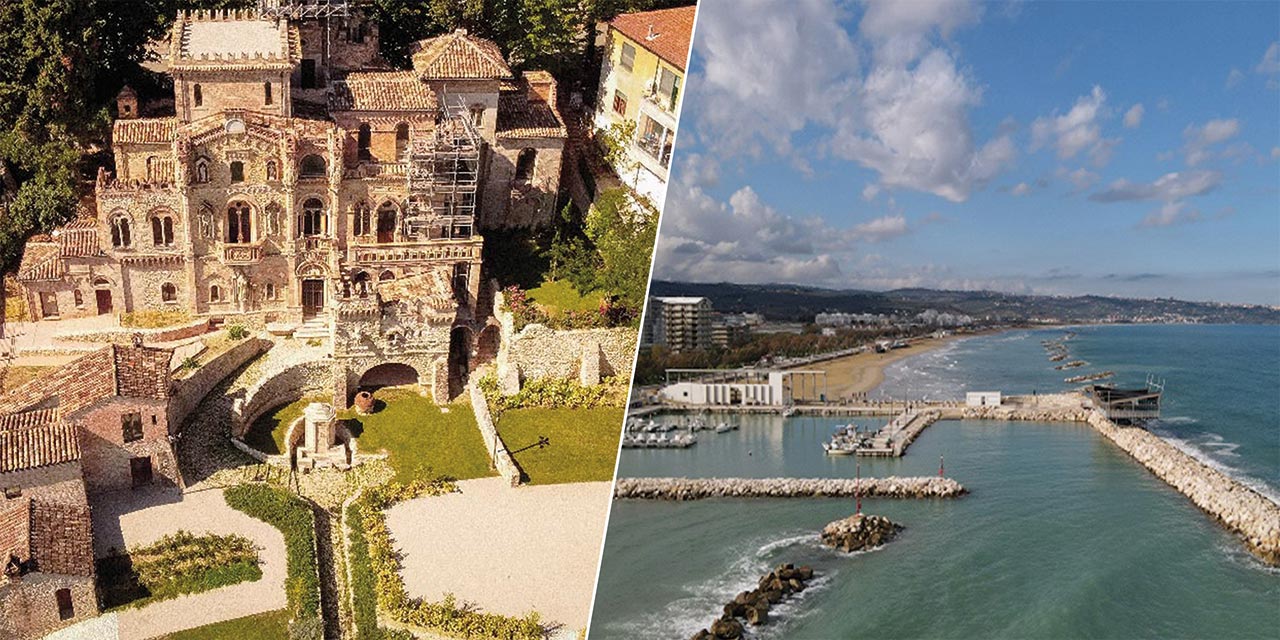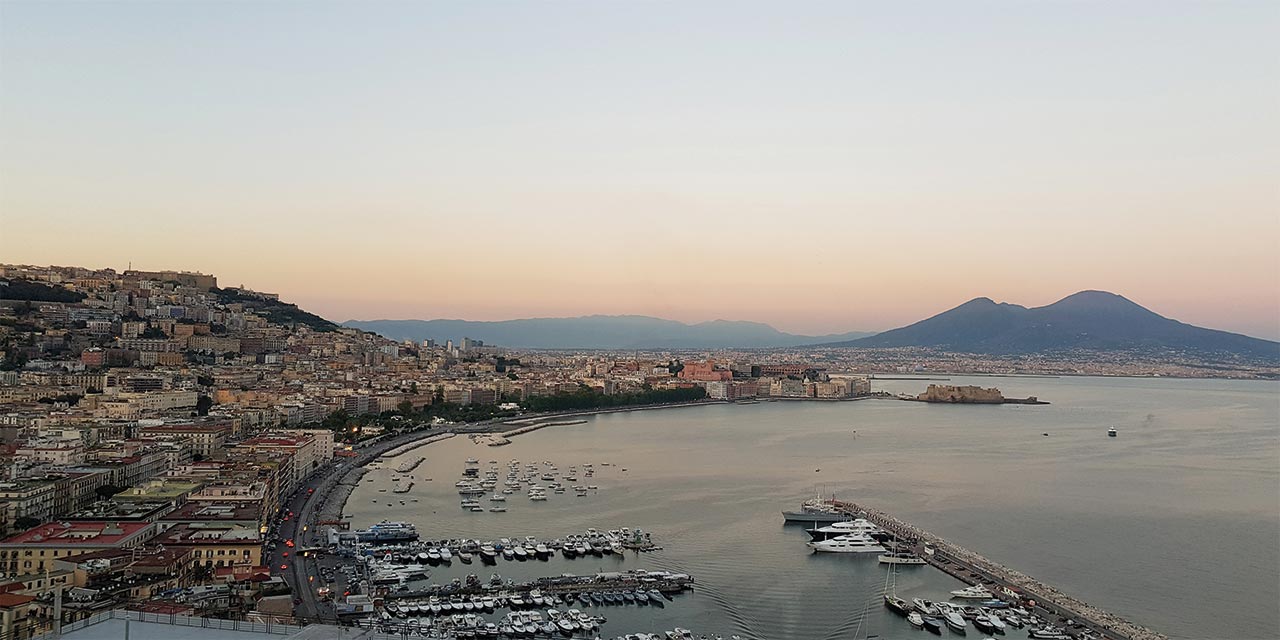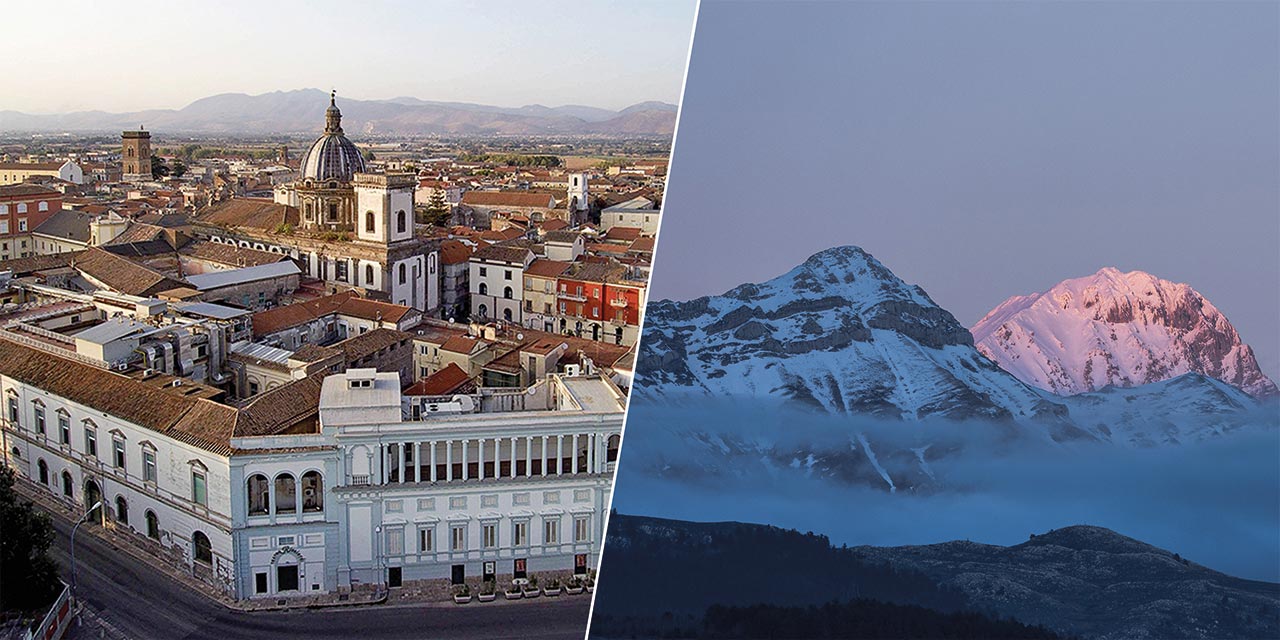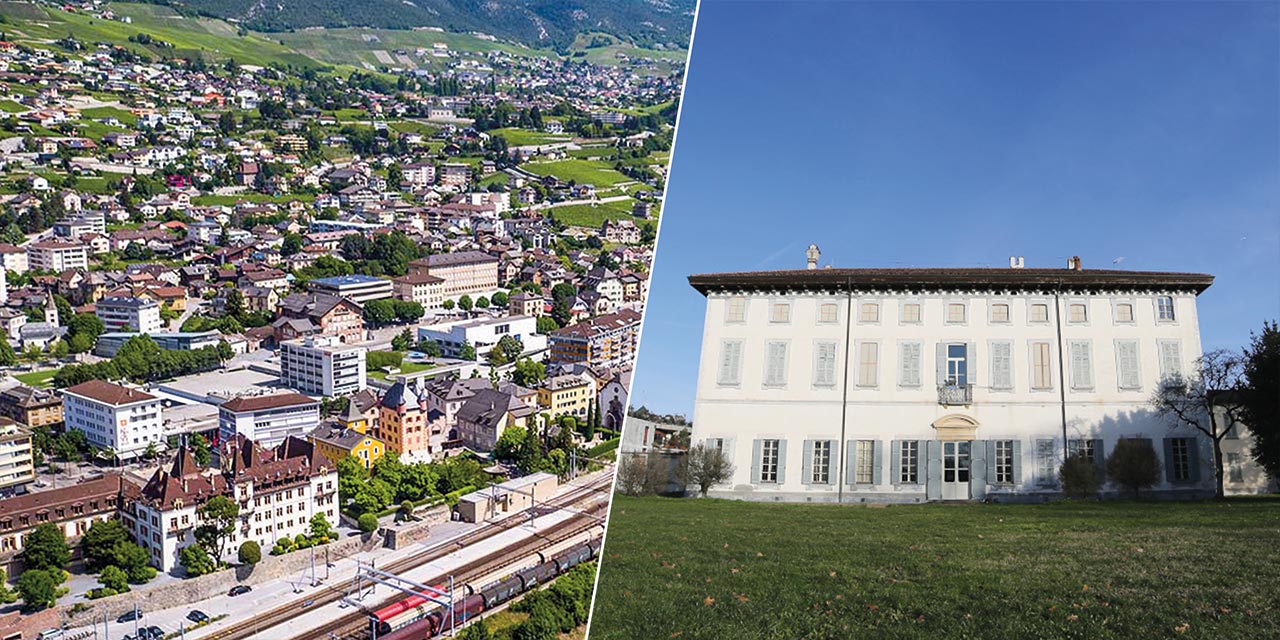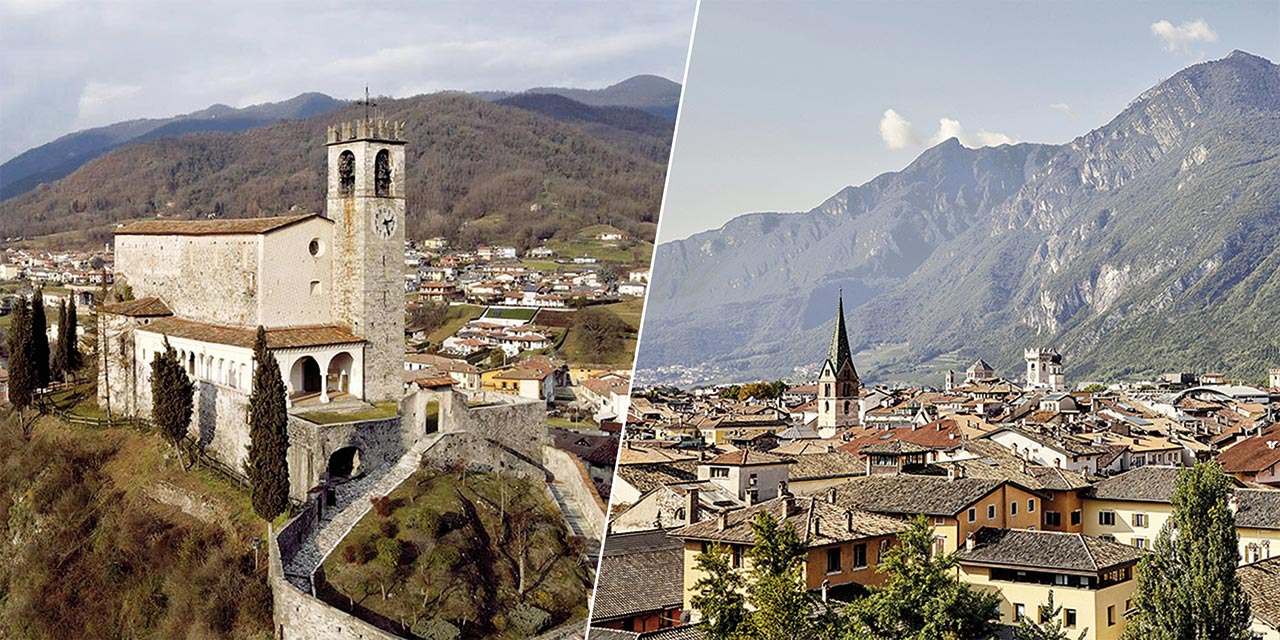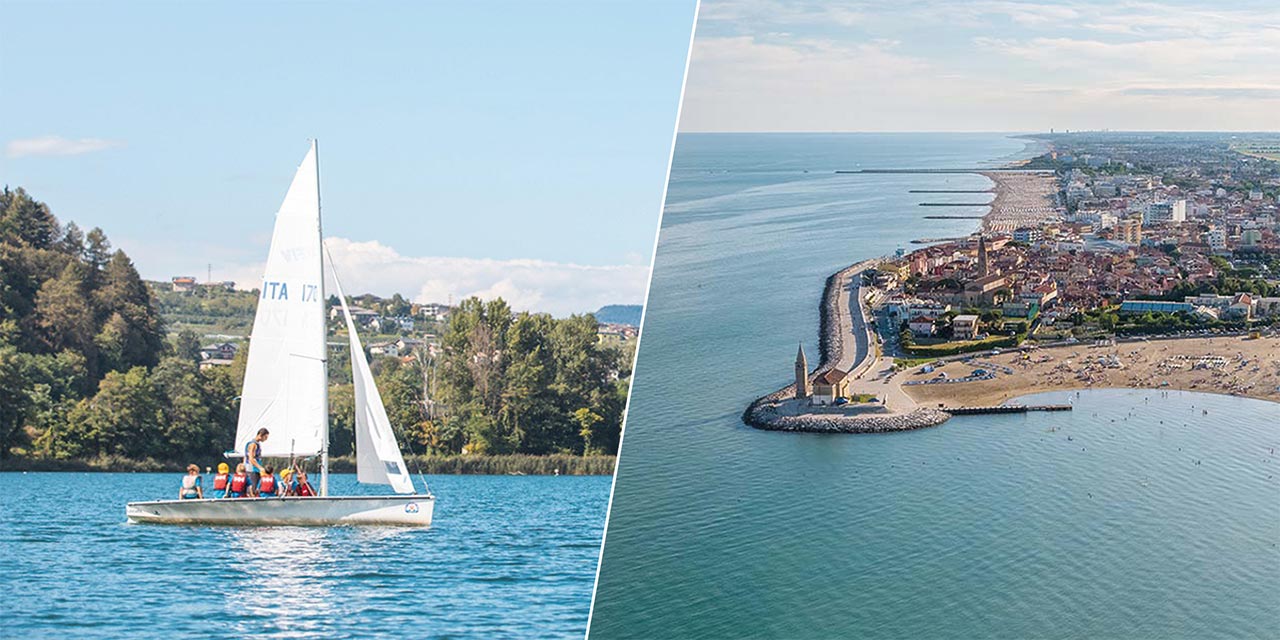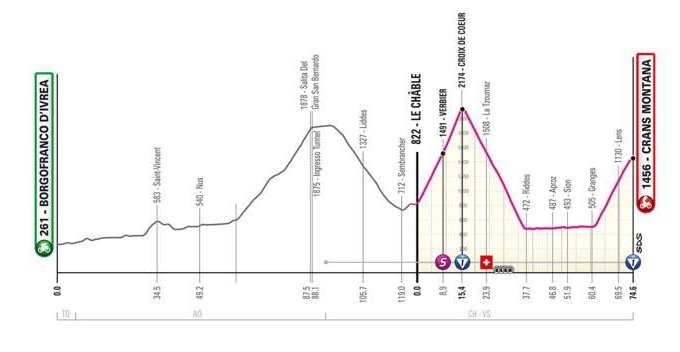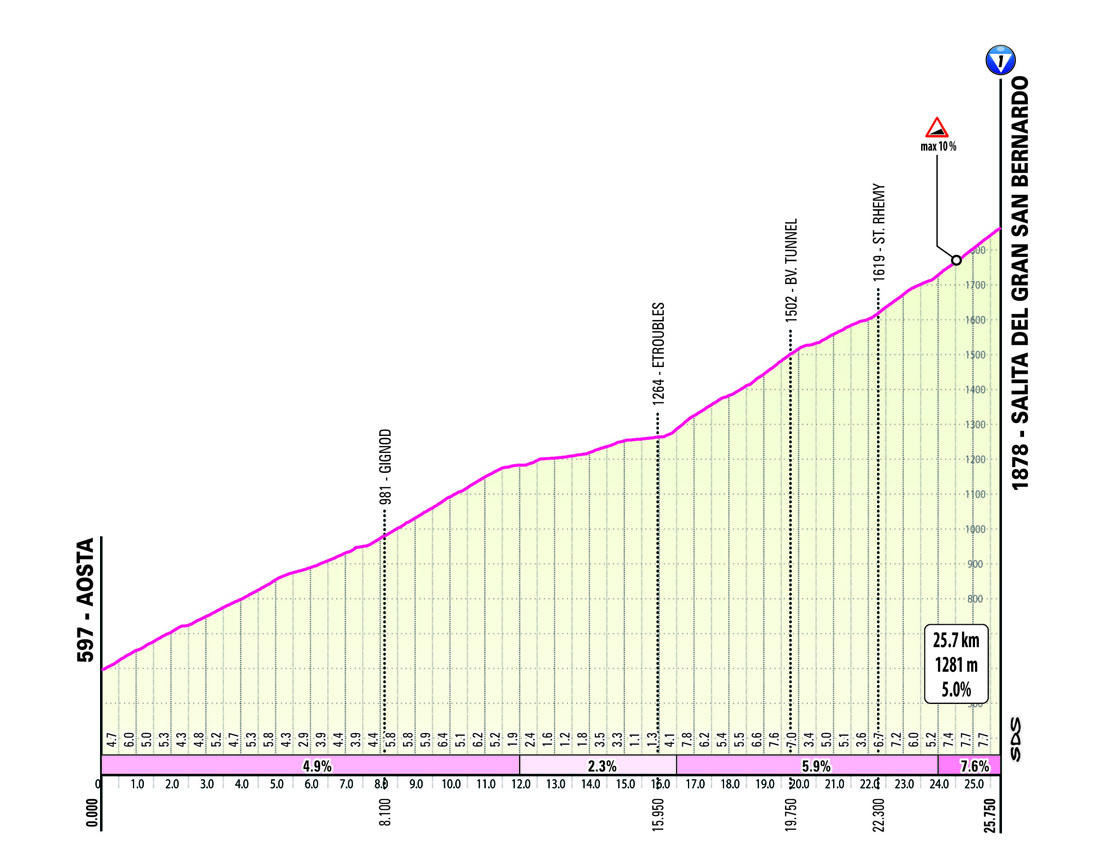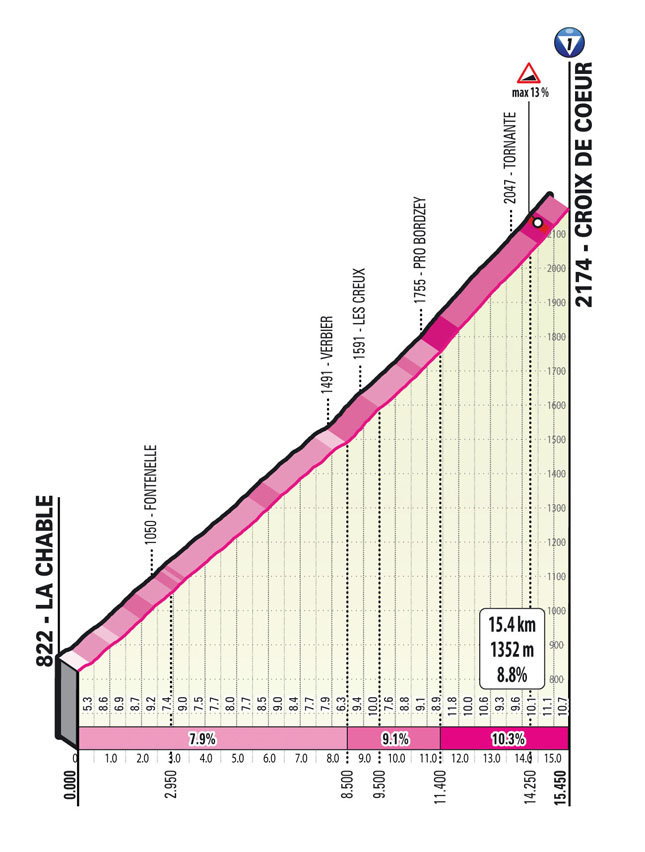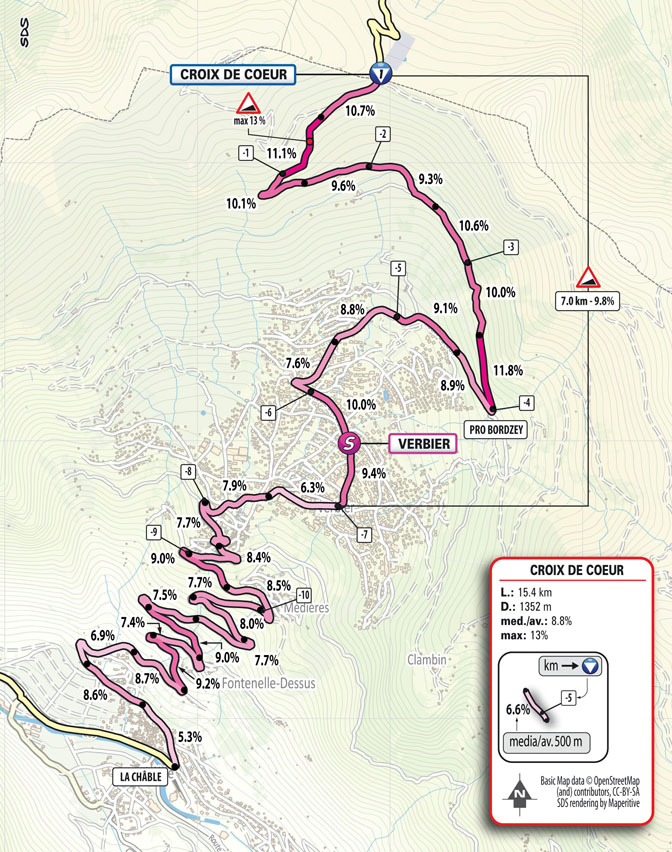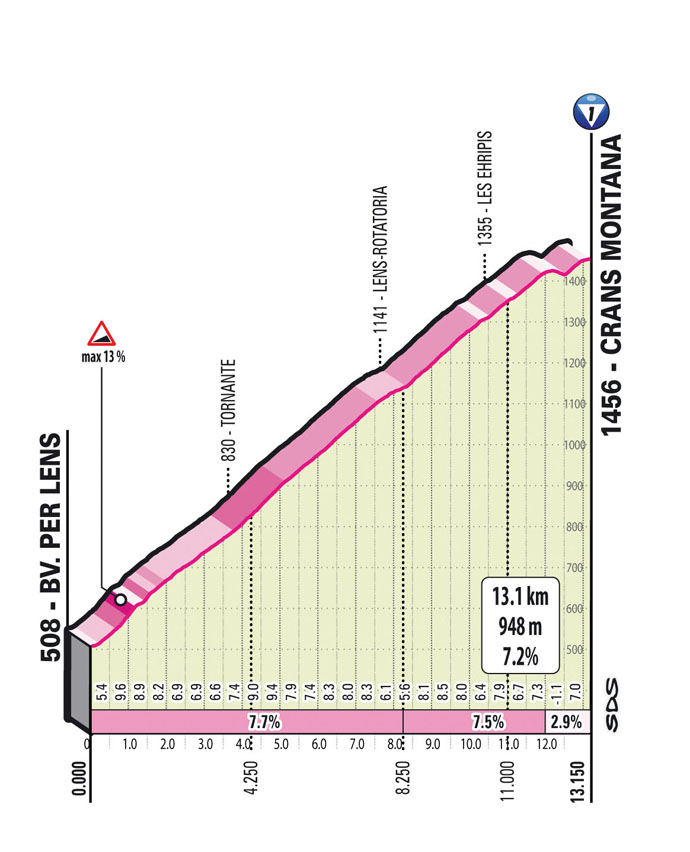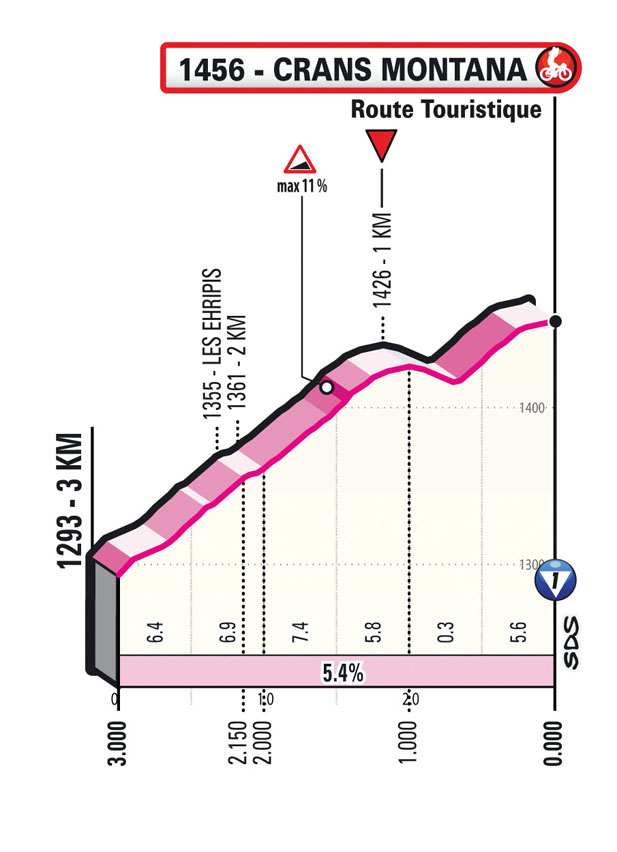profile
map
technical info
Major mountain stage featuring this year’s Cima Coppi. The route winds its way up the Valle d’Aosta region before reaching its principal city, Aosta, where the lengthy ascent to the Great St Bernard (26 km at 5.0%) begins, at the end of which the peloton will cross the tunnel into Switzerland. The race is held on wide, well-paved roads for pretty much the entire stage. After the tunnel, the riders will hit the descent to Sembrancher (30 km), followed by a detour to Verbier to tackle the unprecedented Croix de Coeur (15 km at around 9%). This is followed by a demanding descent, featuring a very narrow first part, while the second section is wide and in excellent conditions, with six illuminated tunnels. The peloton will then ride through the Rhone Valley (the only completely flat section of the stage) to the foot of the final climb.
Final kilometres
The closing climb (13 km at 7%) is steep in the first part, with several hairpins. The gradient eases out until the last kilometres, with a mild descent leading into the final stretch. The home straight is 300 m long, on 8 m wide tarmac, and uphill.
start / finish
climb detail
final kilometres
itinerary timetable
tourist info
Host city:
Borgofranco d'Ivrea
Overview
Borgofranco d’Ivrea (Piedmont), small agricultural village, built towards the end of 1200 by the will of the bishop of Ivrea and the Marquis of Monferrato to constitute an outpost in a disputed area ( borgo-franco) Over the centuries and with ups and downs it has been transformed into the current residential complex at the confluence of an important road junction that connects Piedmont, Biella, Valle d’Aosta and from there France and Switzerland and on the Turin-Aosta railway line.
In ancient times, pilgrims from England (Canterbury) and France travelled from Borgofranco to Rome along the Via Francigena. Route still current and much used by slow tourism – sustainable.
A territory crossed by the river Dora Baltea (tributary of the Po) where thesigns left by a history of agro-pastoral economy are still evident: from the ancient Ricetto, almost intact, with the regularity of its streets and the typical rural architecture of the houses consisting of two or three floors with large arched loggias and large “travà” for hay storage and below stables, to the villages scattered around, each with its often very ancient church and a beautiful Romanesque bell tower in the hamlet of San Germano.
What distinguishes Borgofranco from the other villages of Canavese is the extraordinary complex of Balmetti, spontaneous architectures born on the basis of cellars that exploit air currents (“now”) at constant temperature from natural cavities and produced by geo-eventsspecial natural (paleofrana). An extraordinary territory characterized by the charm of an ancient village and the quiet beauty of a varied landscape made of soft hills where nature, art and culture make an interesting visit.
A place that timidly opens its doors offering hospitality and hospitality to tourists constantly looking for excellence. On foot or by bike you can walk the Via Francigena through the municipal territory offers an interesting route so you can admire the terraced vineyards, the complex of Balmetti with the former brewery De Giacomi, the ancient Ricetto and the seventeenth-century Palazzo Marini.
The territory has maintained over time the cultivation of local agricultural products passing down over time the gastronomic specialties ( poor dishes of the peasant cuisine): salami, lard, mocetta, cheese aged in the Balmetti , good wine and typical desserts (canestrelli), the latter consumed by the English Crown.
Food
The Municipality of Borgofranco of Ivrea creating the brand De.CO . and bet on the enhancement of the local products and from that stems a narrow and deep relationship Between the producers and the territory .
All this needs to hold in count the elements of specificity of the typical products and in particular:
- The link of the typical product with the territory and the importance from the specific resources of the territory. In the productive process of the product;
- The collective character arising from the involvement of a plurality of producers between them.
- The link with the local community: the value of the typical product often goes beyond the businesses who commercialize it.
The typical sweet is more known as “canestrello”
Canestrelli from Borgofranco of Ivrea
The “Canestrello” goes back at the medieval time, indeed _ during the feasts they prepared the Nebule, cakes made with flour and butter, these were used to pay for the performances of the actors-clerics and the organizers of the games . In Borgofranco the Canestrelli are produced and exported abroad , especially they arrived at the table of Late Queen Elizabeth of England which used to be an admirer . After the discovery of the Americas, the importation of cocoa in Piedmont (1650) was introduced. This new ingredient was added, characterizing like this the Canestrelli of Borgofranco D’Ivrea as known today. Once the hot plates, that serve to give the mold and the typical shape, were warmed up on the fire, now they are warmed up electrically . These waffles , with various flavors like lemon , vanilla and cocoa, still keep their ancient traditional form : crunchy , very thin and imprinted with coats of arms of the family, these are the characteristics that distinguish those of Borgofranco of Ivrea.
Points of interest
THE VILLAGE OF THE BALMETTI
The balmetti are a series of natural cellars (there are now over 200) leaning against the morainic rocks of the Mombarone massif, in use since ancient times for conservation. They are about a kilometer from the center of the village and extend along the Via Francigena for about 500 meters forming a village of its own, apparently abandoned and uninhabited. The peculiarity of the Balmit (from the term of Celto-Ligurian origin balma (cave), which indicates the shelter under rock, hollowed into the mountain, from which several place names of Piedmontese alpine area) is explained by a unique geo-natural phenomenon: the air currents, locally called òre (aura in Latin), which blow from the bowels of the mountain by slipping into the cracks of the rocks left by the Balteo Glacier, allow to keep constant, inside the cellars, the humidity and temperature, the latter attested on 7/8 C in all seasons. By mitigating the cold winter and refreshing the hot summers the currents create an environment conducive to the storage and storage of food and wine. These buildings, very essential in form, example of spontaneous and popular architecture, are usually composed of one or two floors above ground where the upper floor, if present, is used for convivial meetings and then equipped with potage and fireplace. Along this magical path called “the mountain that breathes” is present ” Balmetti art – Place of art and culture” where you have an artistic path created along the path connecting the Balmetti below with the Balmetti above , the artists’ square as a place and moment of aggregation for the local and tourist community, through the involvement of young people and associations present in the territory becoming also a showcase of local products through tasting events, exposure and distribution.
PARISH CHURCH OF MADONNA DEL ROSARIO AND SAINTS MAURIZIO AND GERMANO
The church was built around the middle of the 17th century and restored just a year later. The interior consists of three naves in Baroque style, the columns are entirely in marble, finely decorated. Next to the main altar there are two other lateral ones, all in marble and in baroque style. On the side you can admire the painting of the Annunciation of the second half of 1600 by Orazio Gentileschi.
CHURCH OF SANTA MARTA
The exterior of the church of Santa Marta is in full medieval style. In 1691 the building underwent substantial changes. The marquis Claudio Marini died in Borgofranco in 1629 and was buried here adjacent to the Palazzo Marini, because at that time it was used as a parish church.
THE CASCINASSA
The Cascinassa in the past was the place where farmers and servants of Count Palma, feudatory of Borgofranco d’Ivrea. Today it is a private residential complex but inside the court you can admire an octagonal fountain in stone slabs (the Paciassa) deep and embedded, that hides a really interesting story as it was used in ancient times as a glacier where the ice formed was subsequently cut and deposited in the balmetto for the preservation of products. It is also still visible the old brick wood oven, for the production of common bread .
PALAZZO MARINI
A bit of history: the Marquis Claudio Marini was invested with the fief of Borgofranco by Duke Carlo Emanuele I of Savoy, on 18 January 1623. The Marini family belonged to the Genoese patriciate with illustrious ancestors. The marquis Claudio died in Borgofranco in 1629 and was buried in the church of S. Marta adjacent to the Palazzo Marini, which at that time served as a parish church. The building complex of Palazzo Marini occupies an almost rectangular lot inside the original medieval village, near the door to Ivrea. It consists of a noble part, to the south, and a rustic service, to the north. The residential part, the most important, consists of a ground floor, a first floor and an attic. There are no cellars, as in all the buildings of Borgofranco, because of the marshy land. The main staircase, located at the side of the entrance hall, connects the porch with the loggia above; the spiral staircase, contained in the cylindrical tower dating back to the last quarter of the thirteenth century. The Marquis Marini invested in 1623 of the feud of Borgofranco, bought a plot of land with pre-existing buildings that he had restored and enlarged by inserting the staircase and the porch with loggia. Palazzo Marini preserves a series of wall decorations dating back to the second quarter of the ‘6oo. (on the walls of the staircase, in the four rooms of the first floor and in the loggia). On the vault of the staircase is painted, between heaven and earth, the myth of Proserpina: below is the cry of Demeter, above the chariot of Pluto that holds his beloved in his arms. The large Hall, which is accessed directly from the staircase, is covered by a ceiling with wooden beams decorated with Savoy knots. Above the elegant stucco fireplace is painted, monochrome, the fire of Troy with the escape of Aeneas. Hall of the seasons: the putti with the body of bifid and twisted fish, hold the entablature of a low architectural structure that runs all around the shutter of the vault. From four openings appear allegories of the seasons. Hall of ethics, painted with muted tones of ochre and green and with bright inserts of ultramarine and red; on each side biblical scenes with captions of comment. Hall of abundance, is certainly one of the earliest examples of the genre in all of Piedmont. In the centre, on the clouds of a golden sky, sits the Abundance. Such iconography can only have been conceived in a period of fortune for the Marini family and must therefore date back to the first half of the century. The Loggia, finally, extends into the back wall with the prospect of a gallery with seven bays. It seems to see, in the frescoes, the intervention of at least three different groups of decorators: in the vault of the staircase, in the first two rooms and in those, of higher quality and more advanced times, “Ethics” and “Abundance”.
THE VIA FRANCIGENA AND CYCLING ROUTES
The Via Francigena is the main road travelled in the past, especially at the beginning of the second millennium, by pilgrims traveling from Canterbury to Rome, place of the martyrdom of Saints Peter and Paul, “in search of the Lost Heavenly Homeland”. In Canavese there is the 45th of the 79 stages of the itinerary made in 900 by Sigeric, Archbishop of Canterbury, and by the same described returning from Rome, where he had received the liturgical vestment, known as the Pallium, from the hands of the Pope. The English archbishop, in fact, described in detail his route to Canterbury, noting in a diary above all the various stopping points. The concentric, the Ivozio and San Germano hamlets and the Via dei Balmetti are part of the Via Francigena in Piedmont. Along the devotional path, pilgrims use to stop at the hostel for accommodation and accommodation. On the right bank of the Dora Baltea is also the bike path of the Via Francigena
DORA BALTEA AND THE RED RIVER
The Dora Baltea (Deura Bàutia in Piedmontese), was born in the Aosta Valley from the confluence, at Entreves della Dora di Ferret and Dora di Vény. Already particularly rich in water, along its route it receives water from minor rivers, enters Piedmont and crosses the town of Borgofranco d’Ivrea heading towards the Po. Along the river, the town has a property that extends for 40 hectares on the banks of the Dora river park. A small tributary of the Dora, called Rio Rossoproveniente from a quarry in the hill and west of the concentric makes a walk along the river particularly interesting. In fact, the rio has a yellow color (golden) due to the leaching upstream of these pigments quarry that were used in ancient times to decorate the facades of the churches using these lands “poor local”.
ROUTE OF THE ALPINE VINEYARDS “Route des Vignobles Alpins” (I Tupiun)
From the town of Borgofranco d’Ivrea to the border with the Aosta Valley Region, the morainic basin is marked by an imposing series of terraces torn from the mountains and cultivated with vines, where rise old medieval villages, with alleys and stone houses leaning against each other. These terraces are made up of alternating dry walls, with functions of support, and fertile morainic soil transported from the valley floor. From each ridge rise rows of pilasters, in stone and whitewashed bricks with a truncated-conical shape surmounted by a «hat» of stone that have suggested the unusual definition of “bacchus temples”. On the pillars rest the trellises or pergolas that support the vine shoots, called in Piedmontese topia or tupiunche constitute the most characteristic aspect of the landscape. The traveller coming from Baio Dora towards the concentric of Borgofranco d’Ivrea, on the left side can admire the topiary architecture of the vineyards on the hills of Montebuono. The grape par excellence is represented by Nebbiolo, while the historical vine cultivar, and still the main one, is the Picotendro cv, characterized by small clusters and closely linked to the terroir of production.
EX BEER FACTORY
Inside the Balmetti it is possible to notice a building that dominates all the others, presenting itself as an interesting finding of industrial archaeology, worthy of attention. It is the brewery De Giacomi, closed for decades, which evokes the deeds of the founder, Luigi De Giacomi, originally from Chiavenna. De Giacomi found in Borgofranco a phenomenon of natural cellars where a cold air blows, coming from cracks in the rock said hours, which keeps the temperature constant. Among the Balmetti family, De Giacomi decided to set up his brewery, exploiting the natural cellars for the preservation of the product. In 1913 the Fratelli De Giacomi Brewery in Borgofranco d’Ivrea produced 12,000 hectoliters of low fermentation beer and employed 60 workers. In 1928, 7,600 hectoliters of beer were produced out of a total Italian of 1,100,000 hectoliters produced by 62 breweries. As early as 1880, the factory had a glacier of 1,000 cubic meters of natural ice.” The brewery Fratelli De Giacomi remains active until the First World War, exploiting the characteristics of the Balmetti in the brewing process.
GIANT BENH BIG – BENCH COMMUNITY
The giant green-blue bench, number 184, of the territory of Borgofranco d’Ivrea is located in Località Montebuono in a panoramic and contemplative point reachable by a short walk through the vineyards.
HYDROTHERAPY ESTABLISHMENT
The large villa built by the De Giacomi family towards the end of 800, surrounded by greenery, was a hydrotherapy establishment. In 1880, during the mining of mineral in the tunnel in the hamlet of Biò (concession of the De Giacomi) a source of arsenical water was discovered at the hydrotherapy center which arouses great medical interest : Following the analysis of the water, that of Borgofranco d’Ivrea, is evaluated as “the best of arsenic waters”, therefore perfect for the treatment of diseases of the blood, respiratory tract, skin, intestines and nervous system. The mineral water bottling plant in the early 1900s was expanded and embellished until 1936 when the property sells the companies.
IVREA 5 LAKES PARK
Cinque Laghi della Serra – Sirio, Pistono, Nero, di Campagna, San Michele- are scattered over an area of about 10 square kilometers around the city of Ivrea. The Black Lake of Borgofranco d’Ivreais mainly fed by rain and is characterized by a picturesque island in the southern part. Its name comes from the dark color of the water, resulting from the dense vegetation that surrounds it.
PARAGLIDING SCHOOOL CLUB CAVALLARIA
Paragliding in Cavallaria is a free flying discipline practiced since the 80s. The take-off takes place from Cima Cavallaria at an altitude of 1446 m asl. from the Casette at an altitude of 1300m above sea level, from the Ferns at an altitude of 920m above sea level and from San Giacomo di Andrate. The landing fields are situated on the territory of Borgofranco d’Ivrea in Baio Dora (Between the municipality of Lessolo and Baio Dora) It is very frequented and it is considered to be an interesting international trail.
Crans Montana
Overview
An idyllic region in the heart of the Alps
An extraordinary valley, nestled in the heart of the Alps, with 300 days of sunshine a year. From the valley to the glaciers via impressive vineyards, its landscapes offer an ideal setting for outdoor activities, be it hiking, cycling, mountain biking or skiing.
It’s precisely the diversity of activities that makes Crans-Montana so unique. From sport to nature, culture to dolce vita, everything is there for you to enjoy yourself thanks to our quality infrastructure. Historic villages and lively town centers, ski slopes and cultural events, traditional raclette and Michelin-star restaurants, demanding cycling routes and creative snowpark modules, mountain biking and shopping in the luxury Rue du Prado; the whole family will spend unforgettable holidays.
Beyond the activities, it is also the nature that surrounds Crans-Montana that seduces its visitors. The sunny Crans-Montana plateau is a veritable balcony with panoramic views of the most beautiful peaks in the Alps. Its landscapes are varied, from vineyards to the Plaine-Morte glacier, and offer a true haven of peace to all fans of great outdoors.
Food
If you like natural products, you will love what Valais produces. Here, we grow tasty seasonings and golden grains, wonderful fruit and excellent wines. Rich harvests infused with thousands of hours of sunshine, and the passion of our wine growers, herdsmen and farmers. Here, in these wild mountains, we have been learning how to reach the heights of quality for centuries.
The difference lies in the flavours: our specialty meats and cheeses are indescribably delicious. Our wildlife is further evidence that everything which comes from Valais is something quite special: Valais Blackneck goats, Valais Blacknose sheep, strong-willed, lovable Herens cattle that are typically native to our valleys.
In Crans-Montana, whether in the resort or on the pistes, when tastebuds quiver every gourmet will find what they’re looking for amongst the huge choice of restaurants which vary from mountain huts to Michelin-starred establishments.
Quality local produce, numerous foodie events, passionate craftspeople and chefs illustrate the wealth of gastronomy in our region. Moreover, it is a great joy for Crans-Montana to include amongst its numerous restaurants, two Michelin-starred establishments, Franck Reynaud‘s l’Ours, and LeMontBlanc from LeCrans Hôtel & Spa. Thanks to their incredible talents, Crans Montana Chefs, who has settled in Valais, sensitively interpret every flavour in our local produce. Although their creations retain a hint of the south, they should naturally be savoured with a fine Valais wine.
And if you’re missing raclette or other Valais specialities, there are plenty of mountain huts and restaurants which will be delighted to welcome you for a traditional mountain dish.
Points of interest
Crans-Montana was founded when two friends living in the valley, Louis Antille and Michel Zufferey, fell in love with this majestic plateau on a hunting trip back in 1893. They went on to open the first hotel, marking the beginning of the story of an entire region.
To celebrate this anniversary, 12 giant illuminated letters spelling Crans-Montana have been installed on the banks of Lake Grenon, in the heart of Crans-Montana. Replicas of these letters can also be found dotted around twelve of the most beautiful viewpoints in the region. So whilst you’re out walking between the valley and the glacier, you’ll come across these 12 letters together with a telescope and video portraits of local celebrities, who will tell you more about a theme closely related to each place.
Summer or winter, on foot or by bike, explore some of the most beautiful places in Crans-Montana.

